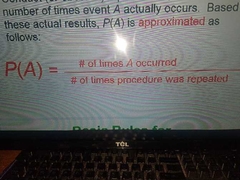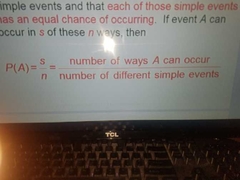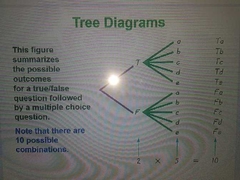![]()
![]()
![]()
Use LEFT and RIGHT arrow keys to navigate between flashcards;
Use UP and DOWN arrow keys to flip the card;
H to show hint;
A reads text to speech;
31 Cards in this Set
- Front
- Back
|
Event |
Any collection of results or outcomes of a procedure |
|
|
Simple event |
An outcome or an event that cannot be further broken down into simpler components |
|
|
Sample space |
for procedure consisting of all possible simple events, that is the sample space consists of all outcomes that cannot be broken down any further |
|
|
Relative frequency approximation of probability |

Conduct or observe a procedure, and count the number of times event a actually occurs. Based on these actual results P(A) is approximated as follows. |
|
|
Classical approach to probability |

Assume that a given procedure has n different simple events and that each of those simple events has an equal chance of occurring. If event A can occur in s of these n ways then |
|
|
Subjective probabilities |
Probability of event A is estimated by using knowledge of the relevant circumstances |
|
|
Simulation |
Process that behaves in the same ways as the procedure itself so that similar results are produced |
|
|
Law of large numbers |
As a procedure is repeated again and again, the relative frequency probability of an event tends to approach the actual probability |
|
|
Probability limits 0 and 1 |
The probability of an impossible event is 0 The probability of an event that is certain is 1 0≤P(A)≤1 |
|
|
Completement of event A |
Ā consists of all outcomes in which the event A does not occur |
|
|
An event is unlikely when |
It's probability us very small, such as 0. 05 or less |
|
|
Actual odds against event A |
P(Ā) ------ P(A) Expressed in the form a:b (or a to b) (reduce using common factors) |
|
|
Actual odds in favor of event A |
P(A) ------ P(Ā) Odds in favor are b:a or b to a |
|
|
Addition rule |
Finding the probability that are expressed as P(A or B), the probability that either event A occurs or event B occurs (or they both occur) as the single outcome of the procedure. Key word is or |
|
|
Compound event |
Any event combining 2 or more simple events
P(A or B)=P(A) + P(B) - P(A and B) P(A and B) only when both occur at the same time as an outcome in a procedure |
|
|
P(A or B) notation |
P(in a single trial, event A occurs or Event B occurs or they both occur) |
|
|
Rule for compound events |
Find the total ways event A can occur and the number of ways B can occur, but find the total in such a way that no outcome is counted more than once |
|
|
Disjoint and mutually exclusive |
Events A and B are disjoint (mutually exclusive) if they cannot occur at the same time. A and Ā are disjoint |
|
|
Multiplication rule |
Used for finding P(A and B), the probability that event A occurs in a first trial and event B occurs in a second trial. Important to adjust probability of B to reflect the occurrence of event A if it's outcome affects B |
|
|
Multiplication rule notation |
P(A and B) means event A occurs in a first trial and event B occurs in a second one
P(B|A) means the probability of event B occurring after event A has already occurred P(A and B) = P(A) • P(B|A) |
|
|
Tree diagrams |

A picture if the possible outcomes of a procedure, shown as line segments. |
|
|
Probability of at least one |
Finding the probability that among several trials, we get at least one of some specified event. At least one is equivalent to "one or more" The complement of getting at least one item of a particular type is that you get no items of that type |
|
|
At least one notation |
P(at least one) = 1 - P(none) Calculate the probability of none and then subtract that result from 1 |
|
|
Conditional probability |
Finding the probability of an event when we have additional information that some other event has already occurred P(B|A) denotes the conditional probability of event B occurring given that event A has already occurred. P(B|A) = P(A and B) --------------- P(A) |
|
|
Confusion of the inverse |
To incorrectly believe that P(A|B) and P(B|A) are the same, or to incorrectly use one value for the other. |
|
|
Fundamental counting rule |
For a sequence of two events in which the first event can occur m ways and the second event can occur n ways, the events together can occur a total of m•n ways |
|
|
Factorial symbol |
Factorial symbol ! denotes the product of decreasing positive whole numbers. 5! = 5•4•3•2•1 By special definition, 0! = 1 |
|
|
Permutations |
Order and rearrangements of the same items counts(ABC is different than (CBA) There are n different items available (this rule does not apply if some items are identical to others) We select r of n items( without replacement) nPr = n! ------- (n - r)! |
|
|
Combinations rule |
There are n different b items
We select r of the n items (without replacement)
Rearrangements of the same items are the same(ABC is the same as CBA) nCr = n! ----------- (n - r)!r! |
|
|
Probability |
Likelihood of occurrence of experiment or event over the total possible outcomes |
|
|
Multiplication counting rule |
Used to find the total number of possibilities from some sequence of events First event occurs n1 ways, second event occurs n2 ways and so on n1 • n2 • n3 |

